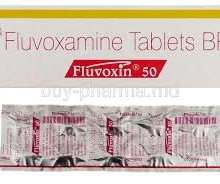Home / Categories / FLUVOXIN-50MG

FLUVOXIN-50MG
(10)
FLUVOXAMINE-50MG
ANTI-DEPRESSANT
SUN PHARMA LTD
Product Details
FLUVOXAMINE
| (flu-VOX-uh-meen MAL-ee-ate) |
| Luvox |
| Tablets: 25 mg, Tablets: 50 mg, Tablets: 100 mg |
| Class: Antidepressant, Selective serotonin inhibitor |
Action Inhibits neuronal reuptake of serotonin in brain.
Indications Treatment of obsessive-compulsive disorder as defined in DSM-III-R.
Contraindications Do not use within 14 days of starting or stopping MAOIs or in combination with cisapride.
Route/Dosage
ADULTS: PO 50 mg as a single dose at bedtime initially. Usual range: 100 to 300 mg/day. Increase dose in 50 mg increments q 4 to 7 days, as tolerated, until max therapeutic benefit is achieved (max 300 mg/day). Give total daily doses > 100 mg in 2 divided doses; if doses are unequal, give larger dose at bedtime. Maintenance: Dosage is adjusted to maintain patient on lowest effective dosage. Periodically reassess need to continue treatment.
Interactions
Lithium, Tryptophan: May enhance serotonergic effects of fluvoxamine.
MAOIs: Similar selective serotonin inhibitors can cause serious (sometimes fatal) reactions. Do not give fluvoxamine in combination with MAOI or < 14 days of discontinuation of MAOI. After stopping fluvoxamine, wait ³ 2 wk before starting MAOI.
Smoking: Increases metabolism of fluvoxamine.
Warfarin, Clozapine, Tricyclic Antidepressants, Benzodiapines (eg, alprazolam, diazapam, midazolam, triazolam), Carbamazepine, Methadone, Metoprolol, Propranolol: Plasma levels of these drugs may be increased.
Cisapride: Increased plasma concentrations of cisapride cause QT prolongation and have been associated with torsades de pointes-type ventricular tachycardia, sometimes fatal.
Lab Test Interferences None well documented.
Adverse Reactions
CARDIOVASCULAR: Palpitations; vasodilation. RESPIRATORY: Upper respiratory infection; dyspnea; yawning. CNS: Headache; somnolence; insomnia; nervousness; dizziness; tremor; anxiety; hypertonia; agitation; decreased libido; depression; stimulation. EENT: Taste perversion; amblyopia. GI: Nausea; vomiting; diarrhea; constipation; dyspepsia; anorexia; flatulence; tooth disorders (eg, toothache, caries); dysphagia; dry mouth. GU: Abnormal ejaculation; urinary frequency; impotence; anorgasmia; urinary retention. DERMATOLOGIC: Sweating; rash; hives. OTHER: Asthenia; flu syndrome; chills.
Precautions
Pregnancy: Category C. Lactation: Excreted in breast milk. Children: Safety and efficacy in patients < 18 yr have not been established. Elderly/Hepatically Impaired Patients: Because of decreased drug clearance, reduce initial dose and titrate slowly. Cognitive and Motor Performance: Patients should use caution in operating potentially hazardous machinery (eg, driving) until they know whether the drug impairs their ability. Use of alcohol also should be avoided. Concomitant Illness: Caution is advised in using drug in patients with diseases or conditions that could affect hemodynamic responses or metabolism (eg, liver dysfunction). Mania/Hypomania: Fluvoxamine may activate hypomania or mania. Use cautiously in patients with history of mania. Seizures: Use with caution in patients with history of seizures. Seizures have been reported in small numbers of patients given this drug.
| PATIENT CARE CONSIDERATIONS |
|
Administration/Storage
- Give starting dose at bedtime.
- If dosage amounts are unequal, give larger dose at bedtime.
- Store at room temperature. Protect from light and humidity.
Assessment/Interventions
- Obtain patient history, including drug history and any known allergies.
- Do not give medication with other MAOI. After discontinuing MAOI, wait 14 days to begin giving fluvoxamine maleate. Before MAOI are resumed, patient must have not taken fluvoxamine maleate for 14 days.
- Monitor hepatic function.
- Monitor for cardiac irregularities.
- Monitor for hypomania or mania in patients with history of these conditions.
- Monitor for seizures in patients with history of seizures.
|
||||
Patient/Family Education
- Explain to men that impotence is a possible side effect.
- Instruct women not to breastfeed while taking medication.
- Tell patient to notify health care provider immediately of cardiac irregularities or seizures.
- Instruct patient to retrain from alcohol intake while taking medication.
- Advise patient to stop smoking while taking medication.
- Advise patient against operating any potentially hazardous machinery until effects of medication on mental status can be determined.
- Instruct patient not to take any prescription or otc medications without notifying health care provider.
- Advise patient to notify health care provider if rash, hives, or related allergic symptoms develop.
Books@Ovid
Copyright © 2003 Facts and Comparisons
David S. Tatro
A to Z Drug Facts
Substitutes
